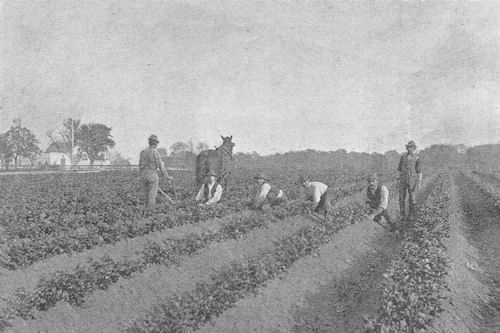FARM GARDENING
WITH HINTS ON
CHEAP MANURING
Quick Cash Crops and How to
Grow Them
Compiled and Published, 1898
by
JOHNSON & STOKES, Seed Growers and Merchants
217 and 219 Market St., Philadelphia, Pa.
Copyright, 1898, by Johnson & Stokes
CONTENTS.
| CHAPTER I. | PAGE. |
| Making the Soil Rich | 9 |
| CHAPTER II. | |
| Choice of Location | 24 |
| CHAPTER III. | |
| Vegetables Suited to Farm Culture Everywhere | 27 |
| CHAPTER IV. | |
| Vegetables Suited to Farm Culture in Some Locations | 75 |
| CHAPTER V. | |
| Sashes and Bedding Plants | 119 |
| CHAPTER VI. | |
| The Strawberry | 121 |
PREFACE.
Farmers in the thickly populated Eastern and MiddleStates, or, in fact, east of the Mississippi River, cannot growgrains nor fatten beeves with the same profit as before theopening of the great West. Dairying still returns fair profits,but there is a widespread demand for cash crops adapted tofarm culture, especially where railroads furnish quick accessto towns and cities.
In response to this demand, we beg to offer a short listof farm vegetables that can be grown with greater profit thangrain, with hints about growing them.
There is no real line dividing the vegetables of the marketgarden from those of the farm garden, but it may be assumedin a somewhat arbitrary way that those which do not yieldat the gross rate of $250 per acre per year will not pay forthe intense culture of high-priced land, although they willpay handsome profits in broad-acred operations under horseculture.
Before offering a list of money crops to farmers we shallhave a word to say in the following pages about economicmanuring. Larger cash receipts and smaller cash expenditureswill result in better bank balances.
CHAPTER I.
MAKING THE SOIL RICH.
Everybody understands that the soil becomes impoverishedby continued cropping, if no return be mad
